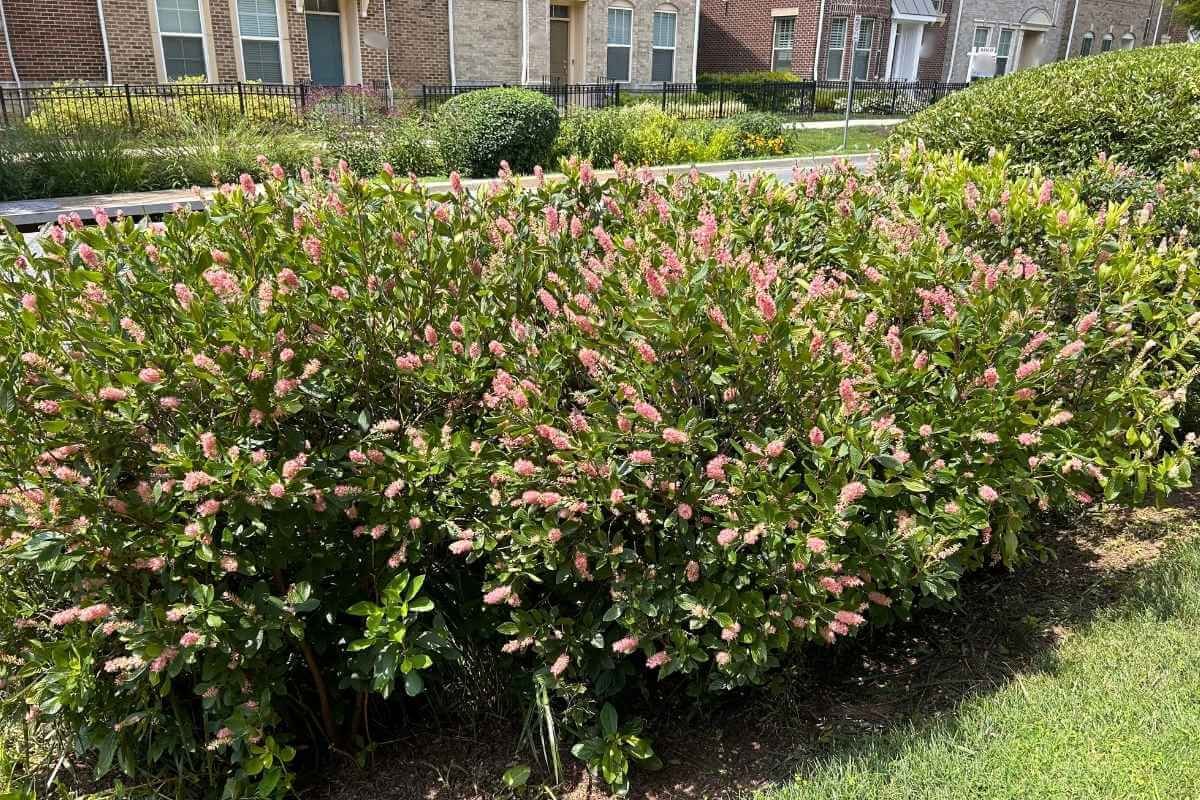The Shade Flowering Ruby Spice Summersweet
Meet Ruby Spice Clethra Alnifolia
Pollinators flock to the bright pink flowers of this versatile shade shrub.
Ruby Spice summersweet (Clethra alnifolia 'Ruby Spice') is a deciduous flowering shrub prized for its fragrant pink blooms and ability to thrive in moist, shady conditions.
A cultivar of the Eastern U.S. native Clethra alnifolia, this bush was developed for its deeper pink flowers, which stand out against the typical white blooms of the straight species.
It blooms in mid-to-late summer, offering a sweet scent that attracts butterflies and other pollinators.
Like its parent species, Ruby Spice summersweet is a hardy, low-maintenance shrub that resists deer and adapts well to various soil types, including wet or poorly drained areas.
It grows 3-6 feet tall and wide, making it a great choice for foundation plantings, woodland gardens, or rain gardens.
Its ability to produce shade flowers while maintaining vibrant color makes it a standout addition to any landscape.
Read on for some design ideas about how to use this versatile shrub in your garden, as well as some suggestions for great planting companions.
Ruby Spice summersweet has bright pink flowers.
Ruby Spice Summersweet Care
Light requirements: Ruby Spice summersweet thrives in full sun to part shade; it grows and flowers in full shade but produces more flowers in sunnier conditions.
Soil needs: Ruby Spice bush prefers moist, well-drained soil; it also tolerates clay, sand, and wet soils.
Planting: Plant Ruby Spice in the early spring or fall, giving young shrubs the chance to establish before the onset of extreme hot or cold weather. Water newly planted shrubs regularly - read “How to Water Your Plants” for help with watering strategies.
Watering: The Ruby Spice bush is a water-loving shrub. It looks and flowers best with consistently moist soil and regular, deep waterings but will tolerate periods of drought once established. Are you in a drought? Check the US Drought Monitor map.
Pruning: Ruby Spice summersweet needs minimal pruning. You can trim it back in late winter or early spring, if desired, to shape the bush and remove dead or damaged branches.
Fertilizing: To promote healthy growth and flowering, apply a layer of compost or leaf mold to the soil each spring. A balanced, slow-release fertilizer can also be used in early spring.
Pest and disease resistance: The Ruby Spice bush is naturally resistant to most pests and diseases.
Mulching: Add a layer of mulch around the base of Ruby Spice summersweet to retain moisture and suppress weeds.
Propagation: Clethra shrubs can be propagated by softwood cuttings in early summer or by the dividing suckers.
Ruby Spice summersweet needs very little pruning.
Summersweet is late to leaf out in the spring. Don’t worry, be patient…it’s worth the wait!
Is Ruby Spice Summersweet Deer Resistant?
Ruby Spice summersweet is a deer-resistant shrub, and deer tend to avoid its fragrant foliage and pink flowers.
Rutgers University rates Ruby Spice summersweet and the entire Clethra alnifolia species (also called sweet pepperbush) as “seldom severely damaged” on its list of Landscape Plants Rated by Deer Resistance.
While no plant is completely deer-proof, deer are less likely to browse the Ruby Spice bush, making it a great choice for gardeners in need of a deer resistant bush with shade flowers.
Pollinators love Ruby Spice summersweet.
How Big Does Ruby Spice Summersweet Get?
Ruby Spice summersweet is a compact and rounded shrub. It typically reaches a mature size of 3 to 6 feet high and wide.
Its moderate growth rate (roughly 1-2 feet per year) makes it well-suited for various garden settings, including borders, side yards and small backyards.
With attractive foliage and sweetly scented blossoms, the Ruby Spice bush adds both beauty and fragrance to the landscape without overwhelming the space.
The leaves of Ruby Spice Summersweet turn a deep golden yellow color in the fall. Image courtesy of Bailey Nurseries.
Where To Plant Ruby Spice Summersweet
Looking for landscaping ideas for Ruby Spice summersweet? This versatile, deer-resistant shrub fits beautifully into many different garden situations. Here are some ideas on where to plant the Ruby Spice bush for the best impact:
Plant a row of Ruby Spice summersweet along the length of a fence, softening the harsh lines of the posts and slats.
Use in a foundation planting or plant at the end of a gutter downspout or gutter extender, where it will happily soaks up water draining from the roof.
Create a mass planting. Summersweet has a suckering habit and can be used to stabilize damp slopes and prevent erosion.
Combine with other evergreens and small trees to create a mixed privacy border.
Plant in any shady, wet area that is prone to standing water or periodic flooding.
Create a deciduous screen by planting summersweet as a hedge. It can also be used delineate property lines.
Use alongside a pond or stream, mimicking its native environment.
Plant in the dappled shade of a woodland garden, where its pink flowers will brighten the space.
Use in a pollinator garden, hummingbird garden, or butterfly garden and watch birds, bees and butterflies flock to the fragrant pink summer blooms.
Plant in a rain garden, where it will happily soak up water in sun or shade!
A mass planting of Ruby Spice summersweet bushes in a rain garden.
Ruby Spice Summersweet Companion Plants
SHRUBS
Sugar Shack® Buttonbush (Cephalanthus occidentalis ‘SMCOSS')
Duke Gardens Plum Yew (Cephalotaxus harringtonia ‘Duke Gardens’)
Ivory Halo® Dogwood (Cornus alba ‘Bailhalo’)
Bailey Red-twigged Dogwood (Cornus sericea ‘Baileyi’)
Ruby Slippers Oakleaf Hydrangea (Hydrangea quercifolia ‘Ruby Slippers’)
Strongbox® Inkberry Holly (Ilex glabra 'ILEXFARROWTRACEY')
Fizzy Mizzy® Virginia Sweetspire (Itea virginica 'SMNIVMM')
Northern Bayberry (Myrica pensylvanica)
Tiny Wine® Ninebark (Physocarpus opulifolius 'SMNPOTW')
Lemony Lace® Elderberry (Sambucus racemosa 'SMNSRD4')
Blue Muffin® Arrowwood Viburnum (Viburnum dentatum ‘Christom’)
Midnight Sun® Weigela (Weigela florida ‘Verweig9')
PERENNIALS
Goat’s Beard (Aruncus dioicus)
Swamp Milkweed (Asclepias incarnata)
Delft Lace Astilbe (Astilbe ‘Delft Lace’)
Blue Wood Sedge (Carex flaccosperma)
Ice Dance® Japanese Sedge (Carex morrowii 'Ice Dance')
Everillo Sedge (Carex oshimensis 'Everillo')
Purple Coneflower (Echinacea purpurea)
Golden Variegated Japanese Forest Grass (Hakonechloa macra ‘Aureola’)
Northern Blue Flag Iris (Iris versicolor)
Raspberry Wine Bee Balm (Monarda didyma ‘Raspberry Wine’)
Garden Girls™ Party Girl Tall Garden Phlox (Phlox paniculata ‘Party Girl’)
Variegated Solomon’s Seal (Polygonatum falcatum 'Variegatum')
Party Girl phlox makes a great Ruby Spice summersweet planting companion. Butterflies can’t resist this duo! Garden Girls™ Party Girl Tall Garden Phlox image courtesy of Walters Gardens, Inc.
Common name: Ruby Spice summersweet, sweet pepperbush, Ruby Spice bush
Botanical/Latin name: Clethra alnifolia ‘Ruby Spice’
Hardiness zones: 4 - 8
Native range: Eastern United States
Light requirements: Full sun to shade
Mature size: 4-6 feet high and 3-5 feet wide
Spacing: 2-3 feet on center
Form: Mounded clump with suckering habit
Growth rate: Moderate (1-2 feet per year)
Flowering time: Summer
Flower color: Pink
Flower form: Spike-shaped clusters of cup-shaped flowers
Leaves: Alternate, simple green leaves with serrated edges
Fall color: Golden yellow
Wildlife value: Attracts bees, butterflies, moths and pollinating insects
Deer resistant: Yes
Looking for water-loving shrubs? Read “Wet Soil Shrubs: 10 Bushes For Soggy Soil”.






